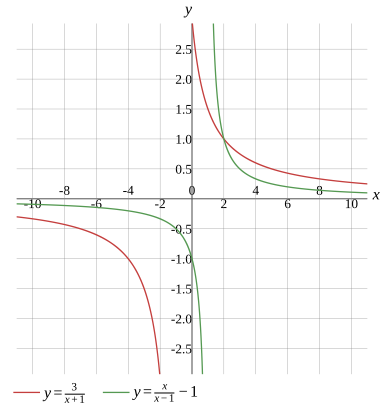Question
Solve the equation
x=2
Evaluate
x+13=x−1x−1
Find the domain
More Steps


Evaluate
{x+1=0x−1=0
Calculate
More Steps


Evaluate
x+1=0
Move the constant to the right side
x=0−1
Removing 0 doesn't change the value,so remove it from the expression
x=−1
{x=−1x−1=0
Calculate
More Steps


Evaluate
x−1=0
Move the constant to the right side
x=0+1
Removing 0 doesn't change the value,so remove it from the expression
x=1
{x=−1x=1
Find the intersection
x∈(−∞,−1)∪(−1,1)∪(1,+∞)
x+13=x−1x−1,x∈(−∞,−1)∪(−1,1)∪(1,+∞)
Multiply both sides of the equation by LCD
x+13×(x+1)(x−1)=(x−1x−1)(x+1)(x−1)
Simplify the equation
More Steps


Evaluate
x+13×(x+1)(x−1)
Simplify
3(x−1)
Apply the distributive property
3x−3×1
Any expression multiplied by 1 remains the same
3x−3
3x−3=(x−1x−1)(x+1)(x−1)
Simplify the equation
More Steps


Evaluate
(x−1x−1)(x+1)(x−1)
Apply the distributive property
x−1x×(x+1)(x−1)−(x+1)(x−1)
Simplify
x(x+1)−(x−1)(x+1)
Use the commutative property to reorder the terms
x(x+1)+(−x+1)(x+1)
Expand the expression
More Steps


Calculate
x(x+1)
Apply the distributive property
x×x+x×1
Multiply the terms
x2+x×1
Any expression multiplied by 1 remains the same
x2+x
x2+x+(−x+1)(x+1)
Expand the expression
More Steps


Calculate
(−x+1)(x+1)
Use the commutative property to reorder the terms
(1−x)(x+1)
Use the commutative property to reorder the terms
(1−x)(1+x)
Use (a−b)(a+b)=a2−b2 to simplify the product
12−x2
Evaluate the power
1−x2
x2+x+1−x2
The sum of two opposites equals 0
More Steps


Evaluate
x2−x2
Collect like terms
(1−1)x2
Add the coefficients
0×x2
Calculate
0
0+x+1
Remove 0
x+1
3x−3=x+1
Move the expression to the left side
3x−3−x=1
Move the expression to the right side
3x−x=1+3
Add and subtract
More Steps


Evaluate
3x−x
Collect like terms by calculating the sum or difference of their coefficients
(3−1)x
Subtract the numbers
2x
2x=1+3
Add and subtract
2x=4
Divide both sides
22x=24
Divide the numbers
x=24
Divide the numbers
More Steps


Evaluate
24
Reduce the numbers
12
Calculate
2
x=2
Check if the solution is in the defined range
x=2,x∈(−∞,−1)∪(−1,1)∪(1,+∞)
Solution
x=2
Show Solution

Graph
